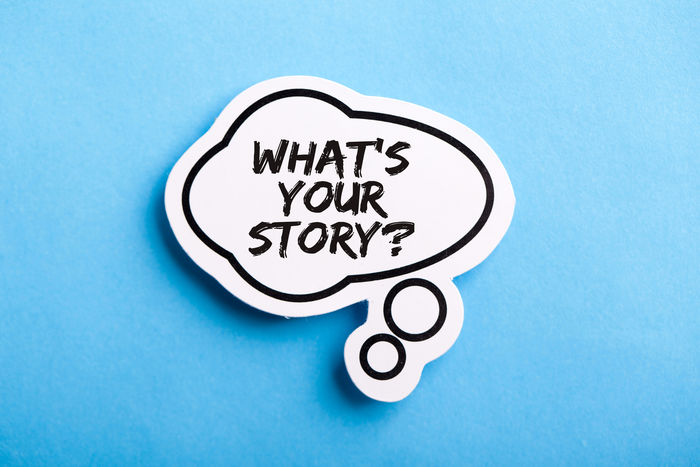For a solid decade, I was a camera slinging, breaking-news chasing, anchor-chair sitting, TV news journalist. It was a wild ride that I was honored to be on.
At my very first TV station, I had hope, optimism, and excitement for all that was to come. Classic newbie attitude. I believed that the stories I told had the potential to enact change, distill critical information, and genuinely move people. And many times, they did. If you think about it, that’s exactly what marketing stories should do too. And even if you weren’t a journalist in a former life, you can think like one. I’ll let you in on the secrets!
Leverage your “sources”
You’ve probably heard the line ‘sources say’ from journalists before. It’s not just a filler line. It doesn’t mean they made up the subsequent statement. It’s a sign that the journalist sought facts from a reputable—but unnamed—individual.
When you write marketing content, who is your source? Do you have one?

Having a “Rolodex” of sources, both within your organization and outside of it, is key to lending credibility and accuracy to your content. Here’s a list of who could be helpful:
- Sales reps
- C-suite members
- Customer service reps
- Employees
- Customers/buyers
- Intermediaries: (dealers, distributors, etc.)
- Compliance department
- Industry experts
Bolster your story with different points of view, facts and statistics, first-hand knowledge, and real-life examples. This comes in handy when you’re writing content for native articles, blogs, press releases, case studies, white papers, emails, and even social media posts.
Tell an actual story
Audiences remember stories. They gravitate toward them. Science even tells us that neural activity in our brain increases when we hear a good story. It’s proof that our human bodies are programmed to respond to stories.
Take these facts outlined in a Harvard Business article:
- Organizational psychologist Peg Neuhauser found that learning that stems from a well-told story is remembered more accurately, and for far longer, than learning derived from facts and figures.
- Psychologist Jerome Bruner’s research suggests that facts are 20 times more likely to be remembered if they’re part of a story.
- Kendall Haven, author of Story Proof and Story Smart, writes, “Your goal in every communication is to influence your target audience (change their current attitudes, belief, knowledge, and behavior). Information alone rarely changes any of these. Research confirms that well-designed stories are the most effective vehicle for exerting influence.”

Joe Lazauskas, head of content at Contently and co-author of The Storytelling Edge, says in an interview with the Content Marketing Institute, “Tell the story of [someone] your audience can relate to, that they can see themselves in, who had the same kind of stubborn boss that you do, who had the same challenges with legal compliance that you do—and tell the story of how she was a hero and overcame them—that story’s going to suck me in much quicker than the story that starts with stats.”
It’s true that sometimes a powerful statistic smacks people in the face with shock and motivates them to act, but it would have to be one heck of a statistic. Statistics can support a story, but your storytelling will win the day.
As a journalist, I attended entire conferences about storytelling. I was a part of storytelling groups on Facebook. I worked hard to develop that muscle and flex it whenever I could—because it works. People remember the good stories, and more importantly, they act on them.
Identify the hook
The hook of a story can be defined in a couple of ways. It’s the “why” behind the story. It’s the reason people should care. It can be the thing that stands out the most. We’ve all had a friend tell a story and at the end of it, we said, “What’s the point?” or “What was I supposed to get out of that?” It’s because the story had no hook. It couldn’t answer the question, “So what?”

It was my job every day to make sure I could answer the “so what?” Some days, the reason was more profound than others, but a reason had to be there nonetheless. Your marketing story should have a point too. You can’t leave audiences wondering why they took the time to listen, read, or pay attention. Your story has to let them know what’s in it for them. That could include:
- A great deal on a product
- More time in their day
- Guaranteed ROI
- Simplified work
- Being smarter, happier, or better looking
One thing to note about your hook: It should NOT be about you and your product. If you look at the list above, all of those things benefit your audience. Even if your story talks about your product and points out why you think it’s great, you must find a way to emphasize the impact it will have on your target audience’s life. Newsflash: Your customers really don’t care about you or your product. They care about how you or your product make their life better, easier, more organized, etc. If all you’re doing is talking about yourself, eventually you’ll only be talking to yourself.
There really is a lot of carryover from journalism into marketing. Every day, you’re tasked with mining for information, really digging for the good stuff. Then, finding the best way to package it, the right words to sell its value, and the optimum time and place to share it.
See how we can help
If you’re interested in putting a journalistic stamp on your content, let me know. I want to make your story the lead story.
Curious about storytelling on social media? Download our helpful guide.

Christine VanTimmeren
christinev@teamddm.com
